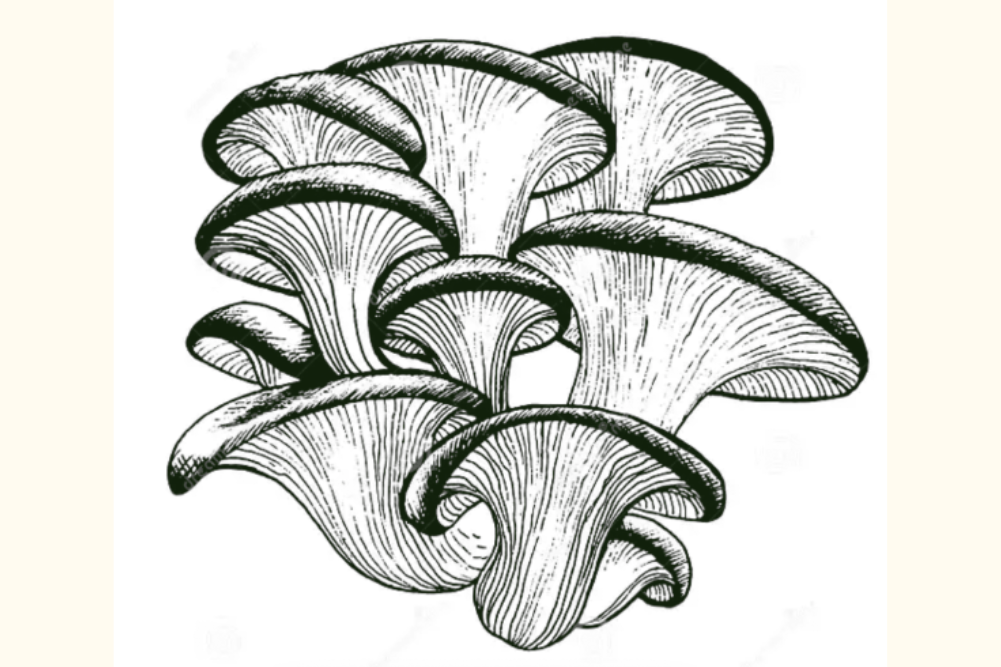Oyster mushroom (Pleurotus ostreatus)
Oyster mushrooms rank as the second most popular edible mushroom worldwide. They grow in the wild and farmers cultivate them on straw and various other substrates. They come in a range of colors, with white or grey being the most common, though they can also be golden yellow, pink, tan, or dark brown. Their flesh and gills remain white.
They spread widely through temperate and subtropical forests and act as “saprotrophs,” meaning they actively decompose dead wood from deciduous trees, particularly beech.
Commercial cultivation first started in Germany as a subsistence food in World War 1. Today, its cultivation comprises 27 per cent of the world’s total mushroom production and plays an important role in advancing food security.
Oyster mushrooms can be prepared in a variety of ways such as soups, stir-fries, stuffed or breaded and as a tasty alternative to meat. A delicacy in Asian cooking, oyster mushrooms can also be used as a vegetarian alternative to oyster sauce in Asian cooking.
Bioremediation — an environmental restorer
Oyster mushrooms bioaccumulate lithium and a range of other environmental compounds. They are lignocellulolytic fungi that use lignin, cellulose, and hemicellulose as carbon and energy sources. This ability gives them impressive bioremediation properties. Their highly efficient enzymatic system enables them to break down a wide range of compounds. They can also grow on substrates that contain toxic chemicals and plastics.
Therapeutic uses in human trials
Oyster mushrooms have traditionally been used as foods and as medicines. Medicinal properties have show numerous benefits. These include immunomodulation, antioxidant, antifungal, antibacterial, antiparasitic and antiviral, cardiovascular, antihypertensive and anti-hypercholesterolaemic, detoxification, anti-inflammatory and anti-diabetic effects.
Active ingredients in oyster mushrooms
Oyster mushrooms are highly nutritious and packed with a wide range of beneficial compounds. They contain polysaccharides, beta-glucans, phenolics, and flavonoids. Additionally, they provide vitamins C, B1, B2, B3, B6, and B9, as well as vitamins A, D, and E. Minerals such as potassium, phosphorus, selenium, and zinc are also present. Other components include glycoproteins, steroids, lectins, alkaloids, superoxide dismutase, fibre, and bioactive proteins like ergothioneine. They are also low in calories, fat and sodium.
Gastrointestinal: The beta-glucan levels in oyster mushrooms make them an ideal prebiotic that has the potential to restore gut microbial balance, particularly evident as people age.
Cardiovascular: Research shows oyster mushrooms act as anti-hypertensives capable of inhibiting ACE and blocking calcium channels with their powerful antioxidant activity. A small human trial on hypertensive and diabetic patients showed consuming oyster mushrooms daily for three months lowered both systolic and diastolic blood pressure significantly (with reductions in HbA1c).
Further studies showed that oyster mushrooms help lower high cholesterol levels. Long-term supplementation of 5 percent oyster mushrooms proved effective. It suppressed diet-induced hypercholesterolemia in rats by inhibiting cholesterol absorption and VLDL synthesis. This also reduced several risk factors linked to atherosclerosis.
Immune: Regular consumption of oyster mushrooms can play a significant role in prevention or treatment of infectious diseases, including acute respiratory viruses, herpes II viral infections, adenoviruses and possibly COVID infections.
Neurological: A Korean study on 87,822 participants showed that consuming mushrooms regularly — particularly oyster mushrooms (more than one serving per month) — demonstrated significantly decreased levels of depressive symptoms, with women and older participants showing a stronger association. The reduction in proinflammatory cytokines and oxidative stress explains these findings, as previous meta-analyses show they contribute to neuropsychiatric disorders.
Endocrine: Rodent studies have demonstrated that consuming oyster mushrooms reduces blood sugar in diabetics. The polysaccharides have beneficial effects on NIDDM, reducing blood glucose, as well as glucose and ketones in the urine.
Further rat studies suggested that the anti-hyperglycaemic effect resulted from healing damaged pancreatic B cells, partially restoring their hormonal activity. This increased peripheral sensitivity to insulin, modulated its synthesis, and boosted glucose utilization in muscle cells.
Oyster mushrooms constitute an incredible resource for sustainable human and environmental needs. They serve as exceptional foods and medicines and grow easily. They play a crucial role in recycling agricultural, pharmaceutical and chemical wastes into valuable compounds to enhance both the environment and human health.
References available on request.








